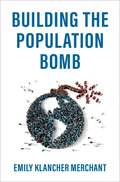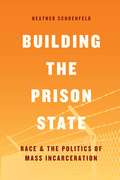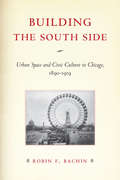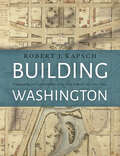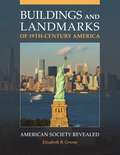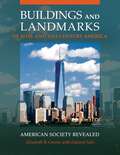- Table View
- List View
Building the Land of Dreams: New Orleans and the Transformation of Early America (PDF)
by Eberhard L. FaberIn 1795, New Orleans was a sleepy outpost at the edge of Spain's American empire. By the 1820s, it was teeming with life, its levees packed with cotton and sugar. New Orleans had become the unquestioned urban capital of the antebellum South. Looking at this remarkable period filled with ideological struggle, class politics, and powerful personalities, Building the Land of Dreams is the narrative biography of a fascinating city at the most crucial turning point in its history.Eberhard Faber tells the vivid story of how American rule forced New Orleans through a vast transition: from the ordered colonial world of hierarchy and subordination to the fluid, unpredictable chaos of democratic capitalism. The change in authority, from imperial Spain to Jeffersonian America, transformed everything. As the city’s diverse people struggled over the terms of the transition, they built the foundations of a dynamic, contentious hybrid metropolis. Faber describes the vital individuals who played a role in New Orleans history: from the wealthy creole planters who dreaded the influx of revolutionary ideas, to the American arrivistes who combined idealistic visions of a new republican society with selfish dreams of quick plantation fortunes, to Thomas Jefferson himself, whose powerful democratic vision for Louisiana eventually conflicted with his equally strong sense of realpolitik and desire to strengthen the American union.Revealing how New Orleans was formed by America’s greatest impulses and ambitions, Building the Land of Dreams is an inspired exploration of one of the world’s most iconic cities.
Building the Modern Church: Roman Catholic Church Architecture in Britain, 1955 to 1975 (Ashgate Studies in Architecture)
by Robert ProctorFifty years after the Second Vatican Council, architectural historian Robert Proctor examines the transformations in British Roman Catholic church architecture that took place in the two decades surrounding this crucial event. Inspired by new thinking in theology and changing practices of worship, and by a growing acceptance of modern art and architecture, architects designed radical new forms of church building in a campaign of new buildings for new urban contexts. A focussed study of mid-twentieth century church architecture, Building the Modern Church considers how architects and clergy constructed the image and reality of the Church as an institution through its buildings. The author examines changing conceptions of tradition and modernity, and the development of a modern church architecture that drew from the ideas of the liturgical movement. The role of Catholic clergy as patrons of modern architecture and art and the changing attitudes of the Church and its architects to modernity are examined, explaining how different strands of post-war architecture were adopted in the field of ecclesiastical buildings. The church building’s social role in defining communities through rituals and symbols is also considered, together with the relationships between churches and modernist urban planning in new towns and suburbs. Case studies analysed in detail include significant buildings and architects that have remained little known until now. Based on meticulous historical research in primary sources, theoretically informed, fully referenced, and thoroughly illustrated, this book will be of interest to anyone concerned with the church architecture, art and theology of this period.
Building the Modern Church: Roman Catholic Church Architecture in Britain, 1955 to 1975 (Ashgate Studies in Architecture)
by Robert ProctorFifty years after the Second Vatican Council, architectural historian Robert Proctor examines the transformations in British Roman Catholic church architecture that took place in the two decades surrounding this crucial event. Inspired by new thinking in theology and changing practices of worship, and by a growing acceptance of modern art and architecture, architects designed radical new forms of church building in a campaign of new buildings for new urban contexts. A focussed study of mid-twentieth century church architecture, Building the Modern Church considers how architects and clergy constructed the image and reality of the Church as an institution through its buildings. The author examines changing conceptions of tradition and modernity, and the development of a modern church architecture that drew from the ideas of the liturgical movement. The role of Catholic clergy as patrons of modern architecture and art and the changing attitudes of the Church and its architects to modernity are examined, explaining how different strands of post-war architecture were adopted in the field of ecclesiastical buildings. The church building’s social role in defining communities through rituals and symbols is also considered, together with the relationships between churches and modernist urban planning in new towns and suburbs. Case studies analysed in detail include significant buildings and architects that have remained little known until now. Based on meticulous historical research in primary sources, theoretically informed, fully referenced, and thoroughly illustrated, this book will be of interest to anyone concerned with the church architecture, art and theology of this period.
Building the Population Bomb
by Emily Klancher MerchantAcross the twentieth century, Earth's human population increased undeniably quickly, rising from 1.6 billion people in 1900 to 6.1 billion in 2000. As population grew, it also began to take the blame for some of the world's most serious problems, from global poverty to environmental degradation, and became an object of intervention for governments and nongovernmental organizations. But the links between population, poverty, and pollution were neither obvious nor uncontested. Building the Population Bomb tells the story of the twentieth-century population crisis by examining how scientists, philanthropists, and governments across the globe came to define the rise of the world's human numbers as a problem. It narrates the history of demography and population control in the twentieth century, examining alliances and rivalries between natural scientists concerned about the depletion of the world's natural resources, social scientists concerned about a bifurcated global economy, philanthropists aiming to preserve American political and economic hegemony, and heads of state in the Global South seeking rapid economic development. It explains how these groups forged a consensus that promoted fertility limitation at the expense of women, people of color, the world's poor, and the Earth itself. As the world's population continues to grow--with the United Nations projecting 11 billion people by the year 2100--Building the Population Bomb steps back from the conventional population debate to demonstrate that our anxieties about future population growth are not obvious but learned. Ultimately, this critical volume shows how population growth itself is not a barrier to economic, environmental, or reproductive justice; rather, it is our anxiety over population growth that distracts us from the pursuit of these urgent goals.
Building the Population Bomb
by Emily Klancher MerchantAcross the twentieth century, Earth's human population increased undeniably quickly, rising from 1.6 billion people in 1900 to 6.1 billion in 2000. As population grew, it also began to take the blame for some of the world's most serious problems, from global poverty to environmental degradation, and became an object of intervention for governments and nongovernmental organizations. But the links between population, poverty, and pollution were neither obvious nor uncontested. Building the Population Bomb tells the story of the twentieth-century population crisis by examining how scientists, philanthropists, and governments across the globe came to define the rise of the world's human numbers as a problem. It narrates the history of demography and population control in the twentieth century, examining alliances and rivalries between natural scientists concerned about the depletion of the world's natural resources, social scientists concerned about a bifurcated global economy, philanthropists aiming to preserve American political and economic hegemony, and heads of state in the Global South seeking rapid economic development. It explains how these groups forged a consensus that promoted fertility limitation at the expense of women, people of color, the world's poor, and the Earth itself. As the world's population continues to grow--with the United Nations projecting 11 billion people by the year 2100--Building the Population Bomb steps back from the conventional population debate to demonstrate that our anxieties about future population growth are not obvious but learned. Ultimately, this critical volume shows how population growth itself is not a barrier to economic, environmental, or reproductive justice; rather, it is our anxiety over population growth that distracts us from the pursuit of these urgent goals.
Building the Prison State: Race and the Politics of Mass Incarceration (Chicago Series in Law and Society)
by Heather SchoenfeldThe United States incarcerates more people per capita than any other industrialized nation in the world—about 1 in 100 adults, or more than 2 million people—while national spending on prisons has catapulted 400 percent. Given the vast racial disparities in incarceration, the prison system also reinforces race and class divisions. How and why did we become the world’s leading jailer? And what can we, as a society, do about it? Reframing the story of mass incarceration, Heather Schoenfeld illustrates how the unfinished task of full equality for African Americans led to a series of policy choices that expanded the government’s power to punish, even as they were designed to protect individuals from arbitrary state violence. Examining civil rights protests, prison condition lawsuits, sentencing reforms, the War on Drugs, and the rise of conservative Tea Party politics, Schoenfeld explains why politicians veered from skepticism of prisons to an embrace of incarceration as the appropriate response to crime. To reduce the number of people behind bars, Schoenfeld argues that we must transform the political incentives for imprisonment and develop a new ideological basis for punishment.
Building the Prison State: Race and the Politics of Mass Incarceration (Chicago Series in Law and Society)
by Heather SchoenfeldThe United States incarcerates more people per capita than any other industrialized nation in the world—about 1 in 100 adults, or more than 2 million people—while national spending on prisons has catapulted 400 percent. Given the vast racial disparities in incarceration, the prison system also reinforces race and class divisions. How and why did we become the world’s leading jailer? And what can we, as a society, do about it? Reframing the story of mass incarceration, Heather Schoenfeld illustrates how the unfinished task of full equality for African Americans led to a series of policy choices that expanded the government’s power to punish, even as they were designed to protect individuals from arbitrary state violence. Examining civil rights protests, prison condition lawsuits, sentencing reforms, the War on Drugs, and the rise of conservative Tea Party politics, Schoenfeld explains why politicians veered from skepticism of prisons to an embrace of incarceration as the appropriate response to crime. To reduce the number of people behind bars, Schoenfeld argues that we must transform the political incentives for imprisonment and develop a new ideological basis for punishment.
Building the Prison State: Race and the Politics of Mass Incarceration (Chicago Series in Law and Society)
by Heather SchoenfeldThe United States incarcerates more people per capita than any other industrialized nation in the world—about 1 in 100 adults, or more than 2 million people—while national spending on prisons has catapulted 400 percent. Given the vast racial disparities in incarceration, the prison system also reinforces race and class divisions. How and why did we become the world’s leading jailer? And what can we, as a society, do about it? Reframing the story of mass incarceration, Heather Schoenfeld illustrates how the unfinished task of full equality for African Americans led to a series of policy choices that expanded the government’s power to punish, even as they were designed to protect individuals from arbitrary state violence. Examining civil rights protests, prison condition lawsuits, sentencing reforms, the War on Drugs, and the rise of conservative Tea Party politics, Schoenfeld explains why politicians veered from skepticism of prisons to an embrace of incarceration as the appropriate response to crime. To reduce the number of people behind bars, Schoenfeld argues that we must transform the political incentives for imprisonment and develop a new ideological basis for punishment.
Building the Prison State: Race and the Politics of Mass Incarceration (Chicago Series in Law and Society)
by Heather SchoenfeldThe United States incarcerates more people per capita than any other industrialized nation in the world—about 1 in 100 adults, or more than 2 million people—while national spending on prisons has catapulted 400 percent. Given the vast racial disparities in incarceration, the prison system also reinforces race and class divisions. How and why did we become the world’s leading jailer? And what can we, as a society, do about it? Reframing the story of mass incarceration, Heather Schoenfeld illustrates how the unfinished task of full equality for African Americans led to a series of policy choices that expanded the government’s power to punish, even as they were designed to protect individuals from arbitrary state violence. Examining civil rights protests, prison condition lawsuits, sentencing reforms, the War on Drugs, and the rise of conservative Tea Party politics, Schoenfeld explains why politicians veered from skepticism of prisons to an embrace of incarceration as the appropriate response to crime. To reduce the number of people behind bars, Schoenfeld argues that we must transform the political incentives for imprisonment and develop a new ideological basis for punishment.
Building the Prison State: Race and the Politics of Mass Incarceration (Chicago Series in Law and Society)
by Heather SchoenfeldThe United States incarcerates more people per capita than any other industrialized nation in the world—about 1 in 100 adults, or more than 2 million people—while national spending on prisons has catapulted 400 percent. Given the vast racial disparities in incarceration, the prison system also reinforces race and class divisions. How and why did we become the world’s leading jailer? And what can we, as a society, do about it? Reframing the story of mass incarceration, Heather Schoenfeld illustrates how the unfinished task of full equality for African Americans led to a series of policy choices that expanded the government’s power to punish, even as they were designed to protect individuals from arbitrary state violence. Examining civil rights protests, prison condition lawsuits, sentencing reforms, the War on Drugs, and the rise of conservative Tea Party politics, Schoenfeld explains why politicians veered from skepticism of prisons to an embrace of incarceration as the appropriate response to crime. To reduce the number of people behind bars, Schoenfeld argues that we must transform the political incentives for imprisonment and develop a new ideological basis for punishment.
Building the Prison State: Race and the Politics of Mass Incarceration (Chicago Series in Law and Society)
by Heather SchoenfeldThe United States incarcerates more people per capita than any other industrialized nation in the world—about 1 in 100 adults, or more than 2 million people—while national spending on prisons has catapulted 400 percent. Given the vast racial disparities in incarceration, the prison system also reinforces race and class divisions. How and why did we become the world’s leading jailer? And what can we, as a society, do about it? Reframing the story of mass incarceration, Heather Schoenfeld illustrates how the unfinished task of full equality for African Americans led to a series of policy choices that expanded the government’s power to punish, even as they were designed to protect individuals from arbitrary state violence. Examining civil rights protests, prison condition lawsuits, sentencing reforms, the War on Drugs, and the rise of conservative Tea Party politics, Schoenfeld explains why politicians veered from skepticism of prisons to an embrace of incarceration as the appropriate response to crime. To reduce the number of people behind bars, Schoenfeld argues that we must transform the political incentives for imprisonment and develop a new ideological basis for punishment.
Building the South Side: Urban Space and Civic Culture in Chicago, 1890-1919 (Historical Studies of Urban America)
by Robin F. BachinBuilding the South Side explores the struggle for influence that dominated the planning and development of Chicago's South Side during the Progressive Era. Robin F. Bachin examines the early days of the University of Chicago, Chicago’s public parks, Comiskey Park, and the Black Belt to consider how community leaders looked to the physical design of the city to shape its culture and promote civic interaction. Bachin highlights how the creation of a local terrain of civic culture was a contested process, with the battle for cultural authority transforming urban politics and blurring the line between private and public space. In the process, universities, parks and playgrounds, and commercial entertainment districts emerged as alternative arenas of civic engagement. “Bachin incisively charts the development of key urban institutions and landscapes that helped constitute the messy vitality of Chicago’s late nineteenth- and early twentieth-century public realm.”—Daniel Bluestone, Journal of American History "This is an ambitious book filled with important insights about issues of public space and its use by urban residents. . . . It is thoughtful, very well written, and should be read and appreciated by anyone interested in Chicago or cities generally. It is also a gentle reminder that people are as important as structures and spaces in trying to understand urban development." —Maureen A. Flanagan, American Historical Review
Building the South Side: Urban Space and Civic Culture in Chicago, 1890-1919 (Historical Studies of Urban America)
by Robin F. BachinBuilding the South Side explores the struggle for influence that dominated the planning and development of Chicago's South Side during the Progressive Era. Robin F. Bachin examines the early days of the University of Chicago, Chicago’s public parks, Comiskey Park, and the Black Belt to consider how community leaders looked to the physical design of the city to shape its culture and promote civic interaction. Bachin highlights how the creation of a local terrain of civic culture was a contested process, with the battle for cultural authority transforming urban politics and blurring the line between private and public space. In the process, universities, parks and playgrounds, and commercial entertainment districts emerged as alternative arenas of civic engagement. “Bachin incisively charts the development of key urban institutions and landscapes that helped constitute the messy vitality of Chicago’s late nineteenth- and early twentieth-century public realm.”—Daniel Bluestone, Journal of American History "This is an ambitious book filled with important insights about issues of public space and its use by urban residents. . . . It is thoughtful, very well written, and should be read and appreciated by anyone interested in Chicago or cities generally. It is also a gentle reminder that people are as important as structures and spaces in trying to understand urban development." —Maureen A. Flanagan, American Historical Review
Building the South Side: Urban Space and Civic Culture in Chicago, 1890-1919 (Historical Studies of Urban America)
by Robin F. BachinBuilding the South Side explores the struggle for influence that dominated the planning and development of Chicago's South Side during the Progressive Era. Robin F. Bachin examines the early days of the University of Chicago, Chicago’s public parks, Comiskey Park, and the Black Belt to consider how community leaders looked to the physical design of the city to shape its culture and promote civic interaction. Bachin highlights how the creation of a local terrain of civic culture was a contested process, with the battle for cultural authority transforming urban politics and blurring the line between private and public space. In the process, universities, parks and playgrounds, and commercial entertainment districts emerged as alternative arenas of civic engagement. “Bachin incisively charts the development of key urban institutions and landscapes that helped constitute the messy vitality of Chicago’s late nineteenth- and early twentieth-century public realm.”—Daniel Bluestone, Journal of American History "This is an ambitious book filled with important insights about issues of public space and its use by urban residents. . . . It is thoughtful, very well written, and should be read and appreciated by anyone interested in Chicago or cities generally. It is also a gentle reminder that people are as important as structures and spaces in trying to understand urban development." —Maureen A. Flanagan, American Historical Review
Building Time: Architecture, event, and experience
by David LeatherbarrowWhile most books on architecture concentrate on spatial themes, this book explores architecture's temporal dimensions. Through a series of close readings of buildings, both contemporary and classic, it demonstrates the centrality of time in modern architecture, and shows why an understanding of time is critical to understanding good architecture.All buildings exist in time. Even if designed for permanence, they change, slowly but inevitably. They change use, they accrue history and meaning, they decay – all of these processes are inscribed in time. So too is the path traced by the sun through a building, and the movements of the human body from room to room. Time, this book argues, is the framework for our spatial experience of architecture, and a key dimension of a building's structure and significance. Building Time presents twelve close readings of buildings and artworks which explore this idea. Examining works by distinctive modern architects – from Eileen Gray to Álvaro Siza and Wang Shu – it takes the reader, in some cases literally step-by-step, through a built work, and provides insightful reflections on the importance of 'making space for time' in architectural design.This is a book for both theorists and for architectural designers. Through it, theorists will find a way to rethink the fundamental premises and aims of design work, while designers will rediscover the order and ideas that shape the world around them-its buildings, interiors, and landscapes.
Building Time: Architecture, event, and experience
by David LeatherbarrowWhile most books on architecture concentrate on spatial themes, this book explores architecture's temporal dimensions. Through a series of close readings of buildings, both contemporary and classic, it demonstrates the centrality of time in modern architecture, and shows why an understanding of time is critical to understanding good architecture.All buildings exist in time. Even if designed for permanence, they change, slowly but inevitably. They change use, they accrue history and meaning, they decay – all of these processes are inscribed in time. So too is the path traced by the sun through a building, and the movements of the human body from room to room. Time, this book argues, is the framework for our spatial experience of architecture, and a key dimension of a building's structure and significance. Building Time presents twelve close readings of buildings and artworks which explore this idea. Examining works by distinctive modern architects – from Eileen Gray to Álvaro Siza and Wang Shu – it takes the reader, in some cases literally step-by-step, through a built work, and provides insightful reflections on the importance of 'making space for time' in architectural design.This is a book for both theorists and for architectural designers. Through it, theorists will find a way to rethink the fundamental premises and aims of design work, while designers will rediscover the order and ideas that shape the world around them-its buildings, interiors, and landscapes.
Building Toys: Bayko and other systems (Shire Library #616)
by Brian SalterThe building-block has been a familiar and much-loved presence in children's toy-boxes for centuries. In the twentieth century, however, new production techniques allowed it to evolve into a multiplicity of systems which enabled any child to be both architect and skilled builder, capable of constructing realistic and sturdy miniature buildings. This beautifully illustrated book is devoted to British building toys, from the well-known to the more niche brands. Photographs of sets, completed buildings and box art and advertising material make this book a feast of nostalgia for anyone who grew up in the middle years of the last century, and an invaluable source of information for any collectors who keep the memory of these toys alive today.
Building Transatlantic Italy: Architectural Dialogues with Postwar America (Ashgate Studies in Architecture)
by Paolo ScrivanoAt the end of the Second World War, America’s newly acquired status of hegemonic power- together with the launch of ambitious international programs such as the Marshall Plan- significantly altered existing transatlantic relations. In this context, Italian and American architectural cultures developed a fragile dialogue characterized by successful exchanges and forms of collaboration but also by reciprocal wariness. The dissemination of models and ideas concerning architecture generated complex effects and frequently led to surprising misinterpretations, obstinate forms of resistance and long negotiations between the involved parties. Issues of continuity and discontinuity dominated Italian culture and society at the time since at stake was the possible balance between allegedly long-established traditions and the prospect of a radical rupture with recent history. Architectural culture often contributed to reach a compromise between very diverging attitudes. Situated in the larger realm of studies on Americanization, this book questions current interpretations of transatlantic relations in architecture. By reconsidering the means and effects of the dialogue that unfolded between the two sides of the Atlantic during the postwar years, the volume analyzes how cultural and formal models were developed in one context and then modified when transferred to a new one as well as the fortune of this cultural exchange in terms of circulation, amplification, and simplification.
Building Transatlantic Italy: Architectural Dialogues with Postwar America (Ashgate Studies in Architecture)
by Paolo ScrivanoAt the end of the Second World War, America’s newly acquired status of hegemonic power- together with the launch of ambitious international programs such as the Marshall Plan- significantly altered existing transatlantic relations. In this context, Italian and American architectural cultures developed a fragile dialogue characterized by successful exchanges and forms of collaboration but also by reciprocal wariness. The dissemination of models and ideas concerning architecture generated complex effects and frequently led to surprising misinterpretations, obstinate forms of resistance and long negotiations between the involved parties. Issues of continuity and discontinuity dominated Italian culture and society at the time since at stake was the possible balance between allegedly long-established traditions and the prospect of a radical rupture with recent history. Architectural culture often contributed to reach a compromise between very diverging attitudes. Situated in the larger realm of studies on Americanization, this book questions current interpretations of transatlantic relations in architecture. By reconsidering the means and effects of the dialogue that unfolded between the two sides of the Atlantic during the postwar years, the volume analyzes how cultural and formal models were developed in one context and then modified when transferred to a new one as well as the fortune of this cultural exchange in terms of circulation, amplification, and simplification.
Building Trust in the International Monetary System: The Different Cases of Commodity Money and Fiat Money (Frontiers in Economic History)
by Giovanni Battista Pittaluga Elena SeghezzaThis book presents the evolution of the international monetary system from the gold standard to the monetary system in force today. It adopts a political economy approach, emphasizing the economic and political conditions under which an international monetary system can come into existence and be maintained over time. This approach highlights how the gradual transition in the international context from commodity money to fiat money has been led by the need for greater elasticity of money supply and smooth adjustments. This transition, however, raises the issue of how to guarantee, over time, the value of a money devoid of intrinsic value. By presenting a historical evolution, the book explains how the existence of an international monetary system based on money without intrinsic value can only occur when a particular balance of power exists at the international level that allows for the production of trust in a fiat money. The book is a must-read for scholars, researchers, and students in the fields of economic history and international monetary economics, interested in better understanding the evolution of the international monetary system.
Building Washington: Engineering and Construction of the New Federal City, 1790-1840
by Robert J. KapschIn 1790, George Washington and Thomas Jefferson set out to build a new capital for the United States of America in just ten years. The area they selected on the banks of the Potomac River, a spot halfway between the northern and southern states, had few resources or inhabitants. Almost everything needed to build the federal city would have to be brought in, including materials, skilled workers, architects, and engineers. It was a daunting task, and these American Founding Fathers intended to do it without congressional appropriation.Robert J. Kapsch;€™s beautifully illustrated book chronicles the early planning and construction of our nation;€™s capital. It shows how Washington, DC, was meant to be not only a government center but a great commercial hub for the receipt and transshipment of goods arriving through the Potomac Canal, then under construction. Picturesque plans would not be enough; the endeavor would require extensive engineering and the work of skilled builders. By studying an extensive library of original documents;¢;‚¬;€?from cost estimates to worker time logs to layout plans;¢;‚¬;€?Kapsch has assembled a detailed account of the hurdles that complicated this massive project. While there have been many books on the architecture and planning of this iconic city, Building Washington explains the engineering and construction behind it.
Building Washington: Engineering and Construction of the New Federal City, 1790-1840
by Robert J. KapschIn 1790, George Washington and Thomas Jefferson set out to build a new capital for the United States of America in just ten years. The area they selected on the banks of the Potomac River, a spot halfway between the northern and southern states, had few resources or inhabitants. Almost everything needed to build the federal city would have to be brought in, including materials, skilled workers, architects, and engineers. It was a daunting task, and these American Founding Fathers intended to do it without congressional appropriation.Robert J. Kapsch;€™s beautifully illustrated book chronicles the early planning and construction of our nation;€™s capital. It shows how Washington, DC, was meant to be not only a government center but a great commercial hub for the receipt and transshipment of goods arriving through the Potomac Canal, then under construction. Picturesque plans would not be enough; the endeavor would require extensive engineering and the work of skilled builders. By studying an extensive library of original documents;¢;‚¬;€?from cost estimates to worker time logs to layout plans;¢;‚¬;€?Kapsch has assembled a detailed account of the hurdles that complicated this massive project. While there have been many books on the architecture and planning of this iconic city, Building Washington explains the engineering and construction behind it.
Buildings and Landmarks of 19th-Century America: American Society Revealed
by Elizabeth B. GreeneAn invaluable resource for readers interested in architecture and design that demonstrates how the construction, form, and function of key structures in the 19th-century influenced American social, political, economic, and intellectual life.America has always been a nation of thinkers, believers, creators, and builders. Evidence of this is plentiful among the landmarks constructed in the 19th century. Buildings and Landmarks of 19th-Century America: American Society Revealed examines many examples that include homes, office buildings, recreational spaces, military sites, religious buildings, and other landmarks in a variety of geographical locations, discussing the background, architecture, and cultural significance of each. Each engaging, accessible entry not only provides readers detailed information about how the landmark relates to what was going on in American society at the time of its construction but also sparks the reader's interest to research the subject further.As examples, consider that a rural cemetery built in Massachusetts in the early 19th century was the prime influence on public park design and led to the construction of New York's Central Park and many other public parks since. The millionaire industrialist and philanthropist Andrew Carnegie built many of the first free public libraries in the country, which led to the development of municipal public library systems. The huge success of 19th-century world's fairs, like the 1876 Centennial Exhibition and the 1893 World's Columbian Exhibition, had lasting effects on society through the many new products that they introduced to the public. Throughout the book, landmarks are analyzed to elucidate their influence on many aspects of 19th-century society, including the treatment of the mentally ill, impact of religious revivals, growth of leisure and vacation time, and housing for the poor and the western homesteader, among many others.In the "How to Evaluate Buildings and Structures" section, readers are prompted to consider questions such as "What specific purposes did the building or structure have?" "When was it constructed, and what were the circumstances?" and "What was the need it addressed?" Students will learn about the period while also developing the skills of observation and assessment needed to analyze these landmarks and draw meaningful conclusions from them about their context and significance. The discussion of each landmark serves to help readers with these elements of critical thinking, assessment, and analysis.
Buildings and Landmarks of 19th-Century America: American Society Revealed
by Elizabeth B. GreeneAn invaluable resource for readers interested in architecture and design that demonstrates how the construction, form, and function of key structures in the 19th-century influenced American social, political, economic, and intellectual life.America has always been a nation of thinkers, believers, creators, and builders. Evidence of this is plentiful among the landmarks constructed in the 19th century. Buildings and Landmarks of 19th-Century America: American Society Revealed examines many examples that include homes, office buildings, recreational spaces, military sites, religious buildings, and other landmarks in a variety of geographical locations, discussing the background, architecture, and cultural significance of each. Each engaging, accessible entry not only provides readers detailed information about how the landmark relates to what was going on in American society at the time of its construction but also sparks the reader's interest to research the subject further.As examples, consider that a rural cemetery built in Massachusetts in the early 19th century was the prime influence on public park design and led to the construction of New York's Central Park and many other public parks since. The millionaire industrialist and philanthropist Andrew Carnegie built many of the first free public libraries in the country, which led to the development of municipal public library systems. The huge success of 19th-century world's fairs, like the 1876 Centennial Exhibition and the 1893 World's Columbian Exhibition, had lasting effects on society through the many new products that they introduced to the public. Throughout the book, landmarks are analyzed to elucidate their influence on many aspects of 19th-century society, including the treatment of the mentally ill, impact of religious revivals, growth of leisure and vacation time, and housing for the poor and the western homesteader, among many others.In the "How to Evaluate Buildings and Structures" section, readers are prompted to consider questions such as "What specific purposes did the building or structure have?" "When was it constructed, and what were the circumstances?" and "What was the need it addressed?" Students will learn about the period while also developing the skills of observation and assessment needed to analyze these landmarks and draw meaningful conclusions from them about their context and significance. The discussion of each landmark serves to help readers with these elements of critical thinking, assessment, and analysis.
Buildings and Landmarks of 20th- and 21st-Century America: American Society Revealed
by Elizabeth B. Greene Edward SaloThis engaging book uses buildings and structures as a lens through which to explore various strands of U.S. social history, revealing the connections between architecture and the cultural, economic, and political events before and during these American landmarks' construction.During the 20th and 21st centuries, the United States became the dominant world power. The tumultuous progression of our nation to global leader can be seen in the social, cultural, and political history of the United States over the last century, and the country's evolution is also reflected in major buildings and landmark sites across the nation. Buildings and Landmarks of 20th- and 21st-Century America: American Society Revealed documents how the construction, design, and function of famous buildings and structures can inform our understanding of societies of the past. Its text and images enable readers to get a deeper understanding of the buildings themselves as well as what happened at each structure's location and how those events fit into our nation's history. Through the study of specific buildings or types of buildings that influenced the cultural, social, and political history of the nation, readers will explore monuments to presidents, learn about how the first tract home neighborhoods came into existence, and marvel at the role of buildings in helping us get to the moon, just to mention a few topics.


